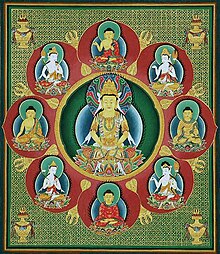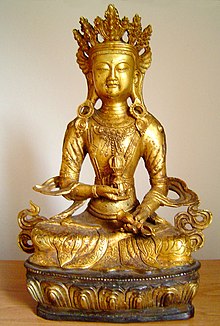Adibuddha
An Adibuddha is a transcendent Buddha who is considered to be the embodiment of absolute wisdom (see also Dharma-Philosophical Meaning ). Adibuddha means original Buddha and he belongs to the Dharmakaya , the level of duality-free, at the same time transcendent and immanent absolute truth and reality, which defines the essence of all Buddhas.
The idea of Adibuddha should be in the 6./7. Century and was adopted from Tantrayana in Mahayana Buddhism . The best known are the "five great transcendent Buddhas" (also: Dhyani Buddhas; Tib .: sku lnga rgyal po ) Vairocana , Akshobhya, Amitabha , Ratnasambhava and Amogasiddhi . The typology of the five Buddha families ( Buddhakula ) also forms the basic structure of the deities visualized in sadhana .
Vairocana
The best-known Adibuddha is Vairocana ( Sanskrit : वैरोचन, Chinese 毘盧遮那 佛 , Pinyin Piluzhenafo , Japanese Birushana-butsu , Korean Birokana or semantically- ajar 大 日 如 來 / 大 日 如 来 , Dàrì Rúlái , Japanese. Dainichi Nyōrai , tib . : རྣམ་ པར་ སྣང་ མཛད ། rNam-par-snang mdzad , Mongolian: Teyin böged geyigülügci , viet .: Đại Nhật Như Lai ; "The sun equals"), which dominates the center of the highest mandala . He shines through the universe and is considered omniscient (Sarvavid). He unites the wisdom of all Buddhas and is also considered a cosmic Buddha who conditions everything. Vairocana is the Lord of the Buddha family and, when one meditates on the Buddhas of this Buddha family, transforms ignorance ( Avidya ) into the nature of all Buddhas, the wisdom of ultimate realization . He is sometimes depicted with four faces, with which he looks in all parts of the world. Its symbol is a solar disk and its mudra is the right index finger, enclosed by the left hand, as a symbol of the union of opposites. In Chinese Hua-yen and Japanese Shingon , Vairocana plays a major role and is worshiped. In the mandala he is surrounded by one hundred and sixty-three appearances of the pantheon - these include the Buddhas of the four cardinal points, Akshobya, Amitabha, Ratnasambhava and Amoghasiddhi, the Tathagatas , who belong to the Sambhogakaya level.
Akshobhya
Akshobhya (Tib .: mi bskyod pa ; "The Unshakable") is the head of the Buddhas of the Vajra family . The Buddhas of the Vajra family are assigned to the disturbing feeling of anger and, if one meditates on the forms of this family, transform it into mirror-like wisdom . It is assigned to the east. His pure land is called Abhirati .
Vajrasattva
In Nepal and northern India, the Sambhogakaya Buddha Vajrasattva (Tib .: rdo rje sems dpa ' (Dorje Sempa); "Diamond Spirit ") is often worshiped instead of Akshobhya as Adibuddha and the highest transcendent Buddha of the Vajra family. The Sambhogakaya body is a kind of light body or better, subtle body that Buddhas adopt to appear to realized yogis and bodhisattvas . It cannot be perceived by ordinary sentient beings, or only to a limited extent.
Vajrasattva means “who has the vajra as his essence”. He wears the jewelry of the Sambhogakaya and is therefore depicted with a five-pointed headdress, necklace and bracelets. He holds the vajra in his right hand and the bell (ghanta) in his left hand, symbolizing the union of opposites, since the vajra is male and symbolizes compassion , while the bell is female and embodies wisdom . Vajrasattva is considered to be the Buddha who embodies the purity of all Buddhas from karmic veils. The practice on Vajrasattva is therefore one of the most important tantric cleansing practices. Vajrasattva is of great importance in the transmissions of Dzogchen , the Great Perfection , which are passed on as the essence of the Buddha's teachings , especially in the Nyingma school of Tibetan Buddhism.
Amitabha
The "Buddha of Boundless Light" is Lord of the Buddhas of the Lotus Family and is enthroned in the Pure Land of Sukhavati . The Buddha-forms of the lotus family are assigned to the disturbing feeling of greed and transform it into the wisdom that distinguishes the disturbing feeling . He is assigned to the west. Important sambhogakaya emanations from Amitabha are the bodhisattva Avalokitesvara and the Buddha of long life Amitayu .
Padmasambhava is considered to be an incarnation of Amitabha , as is Buddha Shakyamuni .
Ratnasambhava
Ratnasambhava (Tib .: rin chen 'byung gnas ) is Lord of the Buddhas of the Ratna (jewel) family. The Buddhas of the Ratna family transform pride into balancing wisdom . It is assigned to the southern region of the world.
Amoghasiddhi
Amoghasiddhi (Tib .: don yod grub pa ), the Buddha of the northern part of the world is Lord of the Buddhas of the Karma family and transforms envy / jealousy into all-perfecting wisdom . So also the meaning of his name: "He who perfects wisdom". In popular belief , he is considered to be the maker of success. The symbol of this family is the double vajra.
Special primordial Buddhas of Vajrayana
Samantabhadra
Another form of Adibuddha, which is essentially only worshiped in Vajrayana , is Samantabhadra (Tib .: Kuntuzangpo ), "the all-good" or "the blessed one around" or "the Lord of truth". It appears naked, without attributes and symbolizes the primal enlightenment of the mind itself, as well as the practice and meditation of all Buddhas. According to the tradition of Tibetan Buddhism, Samantabhadra had never entered samsara . Samantabhadra is closely related to the teachings of Dzogchen (the "great perfection") and is therefore particularly venerated in the Nyingma , but also the Bon schools. The impulse to transmit the teachings of Dzogchen was conveyed by the Dharmakaya Buddha Samantabhadra to the Sambhogakaya form (enlightened energy level) Vajrasattva (T. Dorje Sempa). He transferred Dzogchen to the Nirmanakaya (level of manifestation) and the first human holder of these teachings Garab Dorje . Samantabhadra's hands are clasped in a meditation gesture. In Tantric Buddhism, Samantabhadra (dark blue) is often represented in association with Samantabhadri , his feminine side. They symbolize awareness-voidness, the pure absolute, ever-present and unobstructed nature.
- The base of everything is not composed, it is self-arising, vast and indescribable.
- (from: Gangteng Tulku , Samantabhadra Dzogchen prayer. )
Vajradhara
Vajradhara (Tib .: rdo rje 'chang (Dorje Chang); "diamond holder") is another transcendent Buddha, the sambhogakaya form of samantabhadra and in this form crosses bell and vajra, which at the level of sambhogakaya is the union of practical means and symbolizes wisdom. Its female counterpart is Prajnaparamita , an embodiment of the highest wisdom. Vajradhara is of central importance in the Tibetan schools of Sakya , Kagyu and Gelug , which concentrate on the transmission of the Mahamudra (“Great Seal”) and is there as the starting point for the transmission.
Vajradharma
Vajradharma (Tib .: rdo rje chos (Dorje Chos)) is also considered Adibuddha in the Kagyü school. He is represented like Vajradhara with his hands crossed in front of his heart, holding the vajra and bell, his body color is red. Vajradharma is considered to be the Buddha of the Vajrayogini lineage .
literature
- Gangteng Tulku : Samantabhadra Dzogchen prayer . Khampa Edition, Osterby 2000, ISBN 3-9805251-5-5
- Albrecht Frasch (translator): The king of all wishful prayers, the wishful prayer for noble, extraordinary behavior - as it was spoken by Samantabhadra . Tashi Verlag, Horst 2001, ISBN 3-9806802-4-X
- Gable, Rolf, transl. (2006), The Vairocanābhisaṃbodhi Sutra, Numata Center for Buddhist Translation and Research, Berkeley, ISBN 978-1-886439-32-0 Mahavairocana Sutra PDF
- Shardza Tashi Gyaltsen, Lopon Tenzin Namdak: Heart Drops of Dharmakaya: Dzogchen Practice of the Bon Tradition . Snow Lion Publications, Ithaca 2002, ISBN 1559391723
- Hans Wolfgang Schumann: Mahāyāna Buddhism. The great vehicle across the ocean of suffering. Munich, Diederichs, 1995
Web links
- Mark Schumacher: Godai Nyorai - The Five Tathagata, Especially Important to Shingon Sect of Esoteric Buddhism in Japan (English)
- Namse Bangdzo Bookstore: Five Buddha Families
- www2.bremen.de: Explanation of Vajradhatu Mandala
Individual evidence
- ↑ see graphic ( Memento from July 28, 2011 in the Internet Archive )
- ↑ andyweberstudios.com: Buddha Vajradharma ( Memento of October 4, 2006 in the Internet Archive )
- ↑ In the sadhana of Vajrayogini, the Guru-Yoga practice is based on the figure of Buddha Vajradharma. (Jonathan Landaw and Andy Weber: Images of Awakening. Tibetan Art as an Inner Experience . Diamantverlag, 2000, p. 178, ISBN 3-9805798-1-6 )
- ↑ vajrayogini.com about Vajradharma ( Memento from January 5, 2009 in the Internet Archive )


